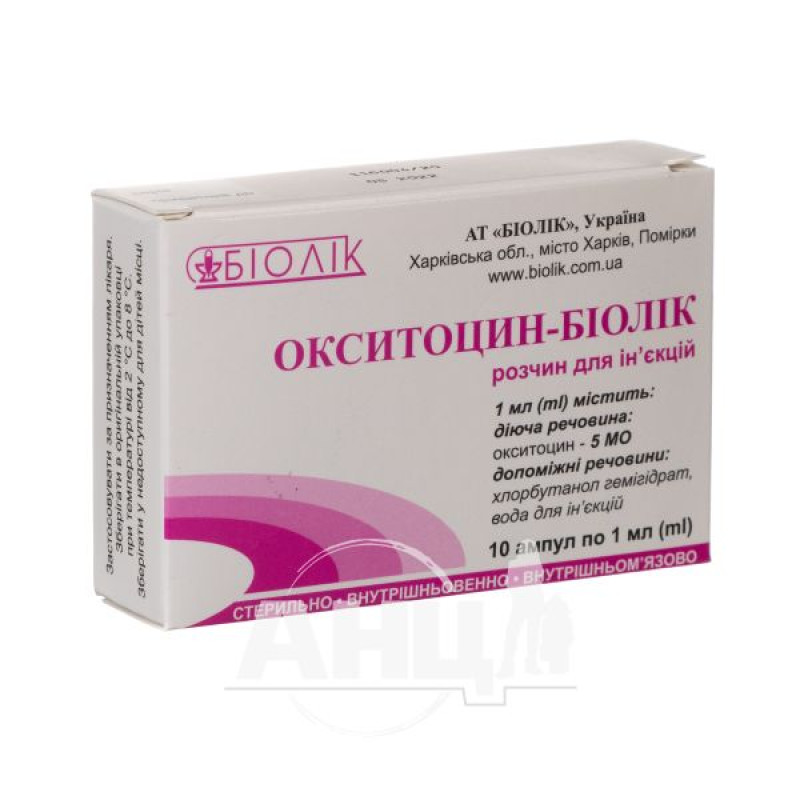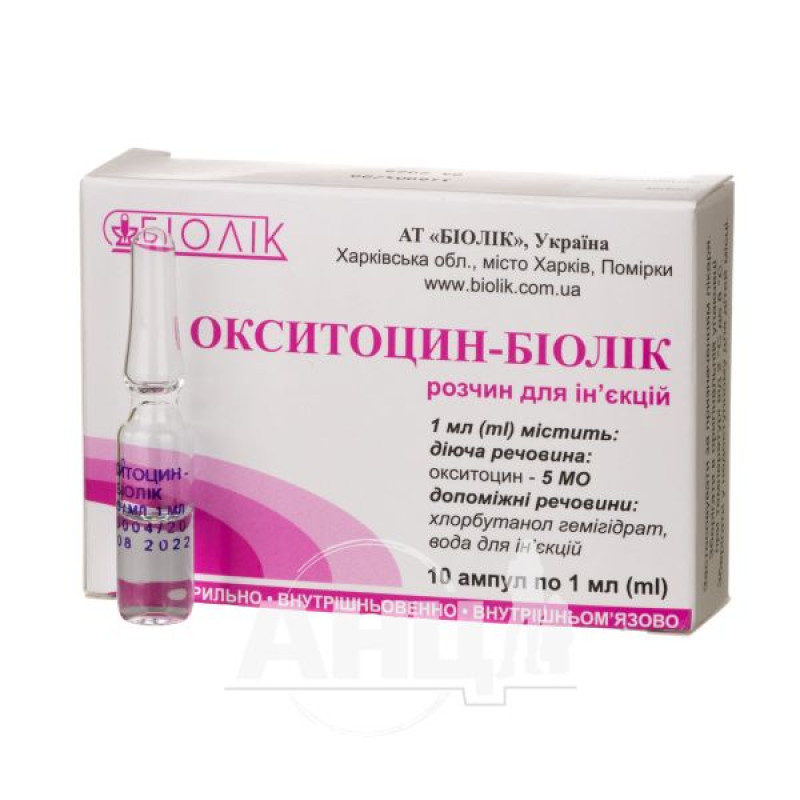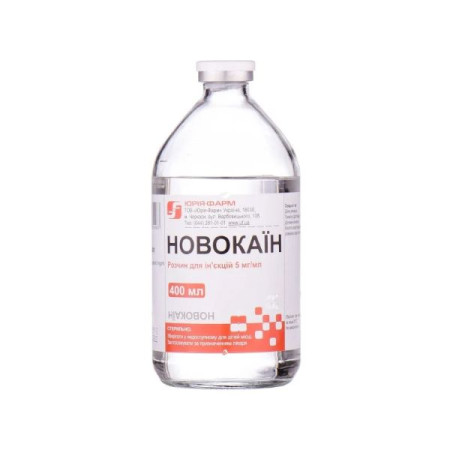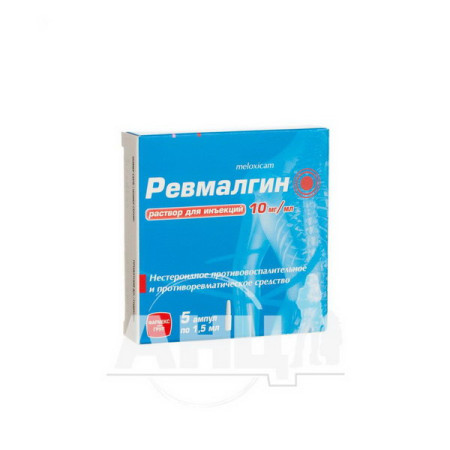Oxytocin-Biolic solution for injection 5 IU/ml ampoule 1 ml No. 10

Pharmacological properties
Synthetic oxytocin has the same biological properties as the natural hormone. The drug causes strong contractions of the uterine muscles, especially in pregnant women, due to the effect on the membranes of myometrial cells. Under the influence of oxytocin, the permeability of membranes for potassium ions increases, their potential decreases and excitability increases. Oxytocin stimulates the secretion of milk, increases the production of the lactogenic hormone of the anterior pituitary gland - prolactin. In addition, the drug promotes the rapid secretion of milk from the mammary gland as a result of its action on its contractile elements. Oxytocin has a weak diuretic effect and does not significantly affect the uterus. Changes in the secretion of oxytocin lead to pathological labor and impaired mammary gland activity during lactation.
The plasma half-life is 3-5 minutes. This hormone is inactivated by the enzyme oxytocinase contained in the blood of pregnant women (the enzyme disappears from the body 10-14 days after delivery), as well as by specific enzymes found in the kidneys, uterus, and retroplacental blood plasma. Due to the absence of proteins in the preparation, its administration is safe from the point of view of the possibility of developing anaphylactic shock and pyrogenic effects.
Indication
For induction of labor and its stimulation in case of weak labor activity (the drug is most effective in case of premature rupture of membranes). It is also prescribed for the prevention and treatment of hypotonic uterine bleeding in the early postpartum period (including to accelerate uterine involution), for artificial induction of labor in case of pregnancy complications, for enhancing uterine contractile activity during cesarean section, and for enhancing lactation.
Application
It is administered intravenously, intramuscularly, and also into the cervix or uterine wall.
To stimulate labor, 0.5-2 IU of oxytocin is injected intramuscularly; if necessary, the injections are repeated every 30-60 minutes. With weak labor activity, prolonged (during the entire labor process) intravenous drip administration of oxytocin at a dose of 5 IU is recommended. Before use, 1 ml (5 IU) of the drug is diluted in 500 ml of 5% glucose solution.
The introduction begins at a rate of 5-8 drops / min, gradually increasing it (every 5-10 min by 5 drops, but not more than 40 drops / min) until the establishment of vigorous labor activity. After its establishment, the amount of solution administered can be reduced to the minimum maintenance. A single intravenous injection of the drug in a dose of 0.2 ml (1 IU) in 20 ml of 40% glucose solution is allowed only if the cervix is fully dilated and there are conditions for rapid natural delivery.
To stimulate contractions, 0.25-1 IU of oxytocin is usually injected intramuscularly.
For the prevention of hypotonic uterine bleeding, oxytocin is administered intramuscularly at 3-5 IU 2-3 times a day daily for 2-3 days; for bleeding, 5-8 IU 2-3 times a day for 3 days. Depending on the clinical situation, it can also be administered intravenously or into the cervix. If necessary, both for prevention and treatment, the drug can be administered again after a 4-5-day break.
During cesarean section (after removal of the fetus), to prevent bleeding, oxytocin is administered intravenously or into the uterine muscle at a dose of 3-5 IU.
To enhance lactation, oxytocin is administered intramuscularly at 1-2.5 IU 30-40 minutes before feeding for 3-5 days.
Contraindication
The use of oxytocin to stimulate labor is contraindicated in cases of mismatch between the size of the mother's pelvis and the fetal head, transverse and oblique position of the fetus, the presence of scars on the uterus after a previous cesarean section or other uterine surgeries, suspicion of premature placental abruption, intrauterine fetal hypoxia, placenta previa, and threatened uterine rupture.
Side effects
When using oxytocin, nausea, vomiting, extrasystole, bradycardia, and fetal cardiac arrhythmia are possible. Allergic reactions in the form of bronchospasm are also possible (in patients with BA).
Special instructions
It is used only under the supervision of a doctor, necessarily taking into account individual sensitivity to the drug. In some cases, after the administration of oxytocin at a dose of 1 unit, sharp contractions may develop, resulting in intrauterine hypoxia of the fetus, in other cases the total dose of the drug may be 4-5 IU. Sometimes, to stimulate labor, oxytocin is prescribed in combination with prostaglandins. With intravenous administration of the drug during labor, it is recommended to use antispasmodic and analgesic agents (promedol, aprofen, etc.) from the beginning of the drip injection. Intravenous administration of the drug causes a rapid increase in contractions (after 1/2-1 min) - sluggish contractions become more intense, and in the absence of contractions they usually appear. Intravenous administration has a less drastic effect. Oxytocin must be used under the control of the contractile activity of the uterus, the condition of the fetus, the uterus and the general condition of the woman.
Overdose
It is manifested by symptoms of uterine hyperstimulation (tetanic contractions of the uterine muscles), preeclampsia, urinary retention, increased heart rate, as well as excessively active labor activity, which can cause acute fetal hypoxia, premature detachment of a normally located placenta, uterine rupture. If signs of complications appear, it is necessary to stop the administration of the drug and carry out symptomatic treatment (reduce fluid intake, apply forced diuresis to remove oxytocin).
Storage conditions
In a dark place at a temperature of 8-20 ° C. Do not freeze!
There are no reviews for this product.
There are no reviews for this product, be the first to leave your review.
No questions about this product, be the first and ask your question.












